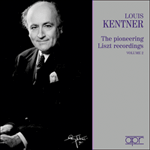
Welcome to Hyperion Records, a British classical label devoted to presenting high-quality recordings of music of all styles and from all periods from the twelfth century to the twenty-first.
Hyperion offers both CDs, and downloads in a number of formats. The site is also available in several languages.
Please use the dropdown buttons to set your preferred options, or use the checkbox to accept the defaults.

Although Liszt’s subtitle accounts for the main material of the piece, the movement is seriously infiltrated by the Coronation March which appears, ghostlike, at the outset, and whose trio section dominates the peroration. The Prière is rather fragmented but introduces the theme ‘Ad nos’ in Meyerbeer’s original compound time (cf. the ‘Ad nos’ Fantasy and Fugue). Quite the most impressive passage is the fanfare which leads from the Hymne to the Marche du sacre, which is itself defiantly four-square.
The mighty ‘Skaters’ scherzo used to be a regular recital war-horse for all players of sufficient stamina from Busoni to Kentner and is the most tightly-constructed piece of the set. Liszt’s sliding effects far exceed the predictable use of glissando and, as everywhere in the collection, his subtle improvements to Meyerbeer’s harmonies, his reorganisation of the original tonalities in order to make a symphonic key structure, and his hinting at one theme whilst exploring another make these pieces superior to many of their kind.
The third piece begins as an engaging variation upon pastoral material, but works itself to a feverish pace before the ‘Ad nos’ theme ushers in the ‘Call to Arms’ march, which itself becomes frenetic and suddenly and brilliantly resolves into the Orgie and a headlong conclusion.
from notes by Leslie Howard © 1992
Bien que le sous-titre de Liszt justifie le matériel principal du morceau, «La Marche du Couronnement» s’insinue vigoureusement dans le mouvement. Elle apparaît, comme une revenante, au départ, et sa section en trio domine la péroraison. «La Prière» est plutôt fragmentée, mais elle introduit le thème «Ad nos» dans la mesure composée originale de Meyerbeer (voir la Fantaisie et la Fugue «Ad nos»). Le passage qui laisse la plus grande impression est sans nul doute la fanfare qui mène de l’«Hymne» à la «Marche du Sacre»—qui, elle-même, est insolemment carrée.
Le puissant scherzo «Les Patineurs» était le cheval de bataille habituel de récital de tous les interprètes qui avaient l’endurance nécessaire de Busoni à Kentner; c’est certainement le morceau le plus solidement construit de toute la collection. Les effets glissants de Liszt dépassent de loin l’utilisation facile à prévoir de glissando et, comme partout dans la collection, son amélioration subtile des harmonies de Meyerbeer, sa réorganisation des tonalités originales destinée à produire une structure tonique symphonique et sa façon de suggérer un thème pendant qu’il en explore un autre rendent ces morceaux bien supérieurs à beaucoup d’autres du même genre.
Le troisième morceau commence par une attirante variation sur un thème pastoral, mais s’intensifie fiévreusement avant que le thème «Ad nos» n’introduise la marche de l’«Appel aux Armes», qui elle aussi devient effrénée avant de se transformer soudain et de façon brillante dans l’«Orgie» et une conclusion impétueuse.
extrait des notes rédigées par Leslie Howard © 1992
Français: Hypérion
Liszts Untertitel nennt zwar die Hauptquellen des musikalischen Materials, doch ist dieser Abschnitt des Werks vor allen Dingen vom „Krönungsmarsch“ durchsetzt, der spukhaft am Anfang erscheint und dessen Triopassage den Schluß bestimmt. Das „Prière“ wirkt recht zerrissen, führt jedoch das „Ad-nos“-Thema im zusammengesetztem Originaltakt Meyerbeers ein (man vergleiche die Fantasie und Fuge „Ad nos“). Die bei weitem eindrucksvollste Passage ist die Fanfare, die von der „Hymne“ zum trotzig unerschütterlichen „Marche du sacre“ überleitet.
Das gewaltige „Schlittschuhläufer“-Scherzo war früher eine regelmäßige konzertante Bewährungsprobe für das Stehvermögen aller möglichen Interpreten von Busoni bis Kentner und ist das am straffsten aufgebaute Stück der Reihe. Liszts Glissando-Effekte gehen weit über das diesbezüglich Übliche hinaus, und seine subtile Vervollkommnung von Meyerbeers Harmonik, seine Neuordnung der Originaltonalität im Sinne einer sinfonischen Tonartstruktur sowie seine Andeutung eines Themas und gleichzeitige Erkundung eines anderen machen diese Stücke genau wie die übrigen dieser Zusammenstellung vielen anderen ihrer Art überlegen.
Das dritte Stück beginnt als entzückende Variation auf ein pastorales Thema, steigert sich jedoch zu fieberhaftem Tempo, ehe das „Ad-nos“-Thema den Marsch „Ruf zu den Waffen“ einleitet. Dieser gerät selbst in wilde Erregung und löst sich plötzlich und brillant sowohl in die „Orgie“ als auch in den ungestümen Abschluß auf.
aus dem Begleittext von Leslie Howard © 1992
Deutsch: Anne Steeb/Bernd Müller
 Liszt: Complete Piano Music Liszt: Complete Piano MusicLeslie Howard’s recordings of Liszt’s complete piano music, on 99 CDs, is one of the monumental achievements in the history of recorded music. Remarkable as much for its musicological research and scholarly rigour as for Howard’s Herculean piano p ...» More |
 Louis Kentner – The pioneering Liszt recordings, Vol. 2 Louis Kentner – The pioneering Liszt recordings, Vol. 2'Excellently transferred from 78s dating from 1939-59, this selection ranges from Liszt’s early exuberance to the grim-faced austerity of his final ye ...  BBC Music Magazine» More BBC Music Magazine» More |

